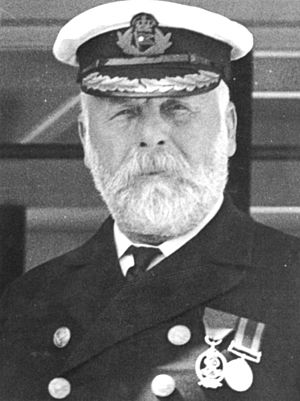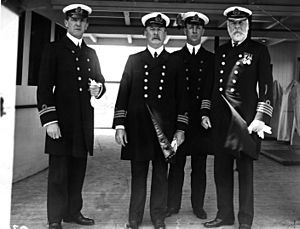Edward J. Smith facts for kids
Quick facts for kids
Edward Smith
RNR
|
|
|---|---|
 |
|
| Born |
Edward John Smith
27 January 1850 Hanley, Staffordshire, England
|
| Died | 15 April 1912 (aged 62) North Atlantic Ocean, 400 miles (640 km) east of Newfoundland
|
| Occupation | Sea captain |
| Employer | White Star Line |
| Known for | Captain of RMS Titanic |
| Spouse(s) |
Sarah E. Pennington
(m. 1887) |
| Children | Helen Melville Smith |
| Parent(s) |
|
| Notes | |
|
Ranks: Commander – RNR (Retired) Captain – White Star Line Honorific rank of commodore, as the White Star Line's most senior captain |
|
Edward John "E. J." Smith was a famous English sea captain. He is best known as the captain of the R.M.S Titanic, a huge ship that sadly sank after hitting an iceberg in 1912. Captain Smith was planning to retire after the Titanic's first trip across the ocean, but he bravely stayed with his ship when it sank.
Contents
Captain Edward Smith's Early Life
Edward John Smith was born on January 27, 1850, in Hanley, Staffordshire, England. His father, Edward Smith, was a potter, and his mother was Catherine Hancock. His parents later owned a shop.
Edward went to the Etruria British School until he was 13. After school, he worked with a steam hammer at the Etruria Forge. When he was 17, in 1867, he moved to Liverpool. He followed in the footsteps of his half-brother, Joseph Hancock, who was a ship captain. Edward began his training on a ship called Senator Weber.
On January 13, 1887, Smith married Sarah Eleanor Pennington. Their daughter, Helen Melville Smith, was born in Liverpool on April 2, 1898. The family lived in a house called "Woodhead" in Highfield, Southampton.
Captain Smith's Career at Sea
Joining the White Star Line
Edward Smith started working for the White Star Line shipping company in March 1880. His first job was as Fourth Officer on the ship SS Celtic. He worked on the company's ships that traveled to Australia and New York City. He quickly moved up in his career.
In 1887, he became a captain for White Star Line, commanding the Republic. The next year, in 1888, Smith earned his Extra Master's Certificate. He also joined the Royal Naval Reserve, becoming a Lieutenant. This meant he could be called to serve in the Royal Navy during wartime. Smith retired from the Royal Naval Reserve in 1905 as a Commander. His ship was special because it could fly the Blue Ensign flag, which was usually for naval ships. Most British merchant ships flew the Red Ensign.
Commanding Bigger Ships
Captain Smith commanded the ship Majestic for nine years, starting in 1895. When the Second Boer War began in 1899, the Majestic was used to carry soldiers to South Africa. Smith made two trips without any problems. In 1903, King Edward VII gave him the Transport Medal for his service.
Smith was known as a "safe captain." As he became more senior, many passengers wanted to sail only on ships he commanded. He even became known as the "Millionaires' Captain."
From 1904 onwards, Smith commanded the newest and largest ships for the White Star Line on their first voyages. In 1904, he commanded the Baltic, which was then the biggest ship in the world. Its first trip from Liverpool to New York in June 1904 went smoothly.
After three years with the Baltic, Smith was given his second new "big ship," the Adriatic. Its first voyage also went well. While commanding the Adriatic, Smith received a special medal for long service in the Royal Naval Reserve.
As one of the world's most experienced sea captains, Smith was chosen to command the first ship in a new group of huge ocean liners, the Olympic. This was the largest ship in the world at that time. The Olympic's first trip from Southampton to New York was successful in June 1911. However, as the ship was docking in New York, a small accident happened. One of the tugboats helping the Olympic got caught in the ship's powerful backwash, spun around, and bumped into the larger ship.
The Hawke Incident
On September 20, 1911, the Olympic had its first big accident. It collided with a British warship called HMS Hawke. The warship lost its front part. Even though the collision damaged two of the Olympic's sections and twisted one of its propeller shafts, the ship was able to return to Southampton.
An investigation decided that the Olympic was to blame. They found that its huge size created a strong pull that pulled the Hawke into its side. Captain Smith was on the bridge during this event.
The Hawke incident cost White Star Line a lot of money. The Olympic had to go back to Belfast for repairs. To fix it quickly, the Harland and Wolff shipyard had to use parts from the Titanic, which was still being built. This delayed the Titanic's completion.
In February 1912, the Olympic lost a propeller blade and needed more emergency repairs. Again, Harland and Wolff took resources from the Titanic to fix the Olympic. This caused the Titanic's first voyage to be delayed from March 20 to April 10.
The Titanic Sinking
When the Titanic hit the iceberg, Captain Smith quickly understood that the ship was in great danger and that many lives would be lost. During the evacuation, Captain Smith did everything he could to prevent panic. He worked hard to help people get into the lifeboats.
Major Arthur Godfrey Peuchen, a passenger, said that Captain Smith was "doing everything in his power to get women in these boats, and to see that they were lowered properly." Robert Williams Daniel, another first-class passenger, called Captain Smith "the biggest hero I ever saw." He said Smith "stood on the bridge and shouted through a megaphone."
Minutes before the ship finally sank, Smith was still releasing the Titanic's crew from their duties. He went to the Marconi radio room and told Junior Marconi Officer Harold Bride and senior wireless operator John "Jack" Phillips they were free to leave. He then walked around the deck one last time, telling crew members: "Now it's every man for himself."
Steward Edward Brown saw the captain with a megaphone. He heard him say, "Well boys, do your best for the women and children, and look out for yourselves.” Brown saw the Captain walk onto the bridge alone just seconds before the ship went down. This was the last reliable sighting of Captain Smith.
Captain Smith died that night along with about 1,500 other people. His body was never found. There are different stories about how he died. Some people claimed to have seen him swimming towards a lifeboat. Others said he went into the wheelhouse on the bridge and died there when the ship was covered by water. The exact way Captain Smith died will likely remain a mystery.
Captain Smith's Legacy
A statue of Captain Smith was put up in July 1914 in Beacon Park, Lichfield. The statue was made by Kathleen Scott, who was the wife of the famous explorer Robert Falcon Scott. The base is made of granite, and the figure is bronze. Lichfield was chosen for the statue because Smith was from Staffordshire, and Lichfield was an important town in the area. The statue cost £740, which was raised by people contributing money.
The plaque below his statue praises his bravery and calm behavior during difficult times. It says he left his countrymen "the memory [and] example of a great heart, a brave life and a heroic death, 'be British.'"
In 2010, the statue was cleaned and restored. In 2011, there was an effort to move the statue to Hanley, Captain Smith's hometown, but it was not successful.
Smith had already been honored in Hanley's Town Hall with a plaque. This plaque read: "This tablet is dedicated to the memory of Commander Edward John Smith RD, RNR. Born in Hanley, 27th Jany 1850, died at sea, 15th April 1912. Whilst in command of the White Star SS Titanic that great ship struck an iceberg in the Atlantic Ocean during the night and speedily sank with nearly all who were on board. Captain Smith having done all man could do for the safety of passengers and crew remained at his post on the sinking ship until the end. His last message to the crew was 'Be British.'"
This plaque was removed in 1961, given to a local school, and then returned to the Town Hall in 1978, but placed inside the building. The Titanic Brewery in Burslem, Stoke-on-Trent is named in his honor.
As a member of the Royal Naval Reserve, Smith wore two special medals when in uniform: the Decoration for Officers of the Royal Naval Reserve and the Transport Medal.
Captain Smith's Family
Captain Smith's mother, Catherine Hancock, lived in Runcorn, Cheshire. Smith had planned to retire there himself. She passed away in 1893. Smith's half-sister, Thyrza, died in 1921. His wife, Sarah Eleanor Smith, was sadly hit and killed by a taxi in London in 1931.
Their daughter, Helen Melville, married and had twins, Simon and Priscilla. Simon became a pilot in the Royal Air Force and was killed during World War II. Priscilla died from polio three years later. Neither of them had children. Helen herself passed away in 1973.
Portrayals of Captain Smith
Captain Edward Smith has been shown in many movies and TV shows:
- Otto Wernicke (1943) in Titanic
- Brian Aherne (1953) in Titanic
- Laurence Naismith (1958) in A Night to Remember
- Michael Rennie (1966) in The Time Tunnel (as "Captain Malcolm Smith")
- Harry Andrews (1979) in S.O.S. Titanic (TV Movie)
- George C. Scott (1996) in Titanic (TV Miniseries)
- Bernard Hill (1997) in Titanic
- John Donovan (2003) in Ghosts of the Abyss (Documentary)
- David Calder (2012) in Titanic (TV series)


